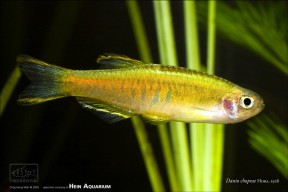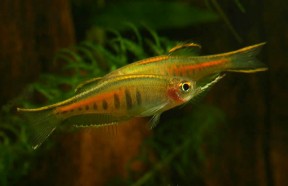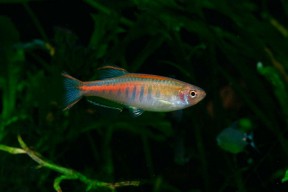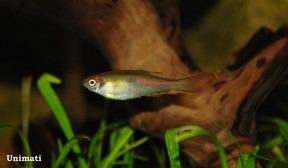Celestichthys choprae
Glowlight 'Danio'
SynonymsTop ↑
Brachydanio choprai (Hora, 1928); Danio choprai Hora, 1928; Danio choprae Hora, 1928
Etymology
Celestichthys: from the Latin caelestis, meaning ‘heavenly’, and ichthys, meaning ‘fish’.
choprae: named for Dr. B. N. Chopra, who collected the original specimens (see ‘Notes’ for information on spelling).
Classification
Order: Cypriniformes Family: Cyprinidae
Distribution
The type specimens were collected from ‘small rocky streams’ of the Mogaung Chaung river system close to the towns of ‘Kamaing’ (often referred to as Kar Maing) and Namma (Nanmati?)in Myitkyina District, Kachin State, northern Myanmar, and the species appears restricted to this tributary of the much larger Ayeyarwaddy drainage.
It’s being bred on a commercial basis so you might find wild caught specimens hard to come by in the aquarium hobby, though.
Specimens from a population of similar-looking fish from the area around Thandwe in Rakhine State on Myanmar’s western coast that were initially misidentified as D. choprae by Hora (1937) were collected in 1998 by Kullander and Britz and eventually described as D. aesculapii by Kullander and Fang (2009).
A third species from the mountainous region of Putao in the far north of Kachin was described as D. flagrans by Kullander (2012).
Myanmar can be considered a centre of diversity for the genus with over ten species, most of which are endemic to the country.
Habitat
This species shows a preference for small hill streams with substrates of gravel and variably-sized rocks. On habitat comprised a larger pool with muddy substrate, no aquatic plants and clear water.
This was located at the foot of a hill and measured around 30 m across and 30-50 cm deep.
An outflow described as a ‘small trickle’, just 30 cm wide and 20 cm deep, emerged from the pool and meandered through surrounding grassland.
Water temperature was 24.8°C/76.6°F, pH 7.6 and conductivity 11 μS · cm−1 (Kullander, 2012).
Maximum Standard Length
One of the smaller members of the genus reaching 25 – 30 mm.
Aquarium SizeTop ↑
Base dimensions of 80 ∗ 30 cm or larger are required for this active species.
Maintenance
Looks particularly effective in a heavily-planted arrangement with a darker substrate, and may appear paler in sparsely-decorated set-ups.
We suggest maintaining it in a well-planted aquarium or set-up designed to resemble a flowing river or stream, with a substrate of variably-sized rocks and gravel and some large water-worn boulders.
Additional powerhead(s) or filter outlets can be used to provide flow but torrent-like conditions should be avoided since small danionins tend to occupy calmer stretches and marginal zones in nature.
Driftwood roots, branches and aquatic plants, with hardy genera such as Microsorum, Bolbitis or Anubias ideal since they can be grown attached to the décor, can also be added.
The aquarium must have a very tightly-fitting cover as members of this genus are accomplished jumpers and can fit through surprisingly small gaps.
Water Conditions
Temperature:16 – 26 °C
pH: 6.0 – 8.0
Hardness: 18 – 215 ppm
Diet
Almost certain to prey chiefly on insects and their larvae in nature. In the aquarium it’s a largely unfussy feeder and will accept most foods.
A good quality dried product can be used as the staple diet but this should be supplemented with regular meals of small live and frozen fare such as bloodworm, Daphnia, Artemia, etc., for the best colouration and conditioning.
Behaviour and CompatibilityTop ↑
Generally very peaceful making it an ideal resident of the well-furnished community tank.
Since it places no special demands in terms of water chemistry it can be combined with many of the most popular fish in the hobby including other small cyprinids as well as tetras, livebearers, rainbowfish, anabantoids, catfish and loaches.
A community based around stream-dwelling species from the Irrawaddy basin would also make an interesting project with possibilities including Badis kyar, Acanthocobitis botia, Botia histrionica, B. rostrata, Lepidocephalichthys berdmorei, Schistura vinciguerrae, Crossocheilus latius, Brachydanio albolineata, Pethia didi, P. erythromycter, P. stoliczkanus, P. ticto, Devario apogon, ‘Inlecypris‘ shanensis, and Rasbora daniconius among others.
It’s a schooling species by nature and really should be kept in a group of at least 8-10 specimens which will develop a pecking order among themselves.
Maintaining it in decent numbers will therefore not only help make the fish less nervous but will allow sub-dominant fish of both sexes some respite from the alpha male(s) which can be quite aggressive at times.
It’s not uncommon to see nipped fins in lesser individuals within a group though this behaviour does not normally extend to tankmates.
Sexual Dimorphism
Sexually mature females are usually rounder-bellied, less colourful and a little larger than males.
The differences are especially clear when the fish are in spawning condition as the males intensify in colour and females fill with eggs.
Reproduction
Like many small cyprinids this species is an egg-scattering spawner that exhibits no parental care.
That is to say when the fish are in good condition they will spawn often and in a densely-planted, mature aquarium it is possible that small numbers of fry may start to appear without human intervention.
However if you want to increase the yield of fry a slightly more controlled approach is required.
The adult group can still be conditioned together but one or more smaller, say 10-15 litre, containers should also be set up and half-filled with water.
These should be very dimly lit and the base covered with some kind of mesh of a large enough grade so that the eggs can fall through it but small enough so that the adults cannot reach them.
The widely available plastic ‘grass’-type matting can also be used and works very well; alternatively filling much of the tank with Java moss or other fine-leaved plant can also yield good results.
The water itself should be of slightly acidic to neutral pH with a temperature towards the upper end of the range suggested above.
A small power filter can be added initially and this should be positioned so that the flow is directed down the full length of the tank.
When the adult fish are well-conditioned and the females appear full of eggs one or two pairs should then be introduced to each container.
Spawning can be initiated by adding small amounts of cool water every few hours in such a way that the tank is gradually topped up and feeding small amounts of live and frozen foods.
The pair should spawn the following morning. The easiest and quickest way to tell is simply to look at the female since if the fish have spawned she will be noticeably slimmer.
The adults will eat any eggs they find and are best removed after a couple of days at which point the power filter should be switched for a mature sponge-type unit in order to avoid fry being sucked into the mechanism.
Incubation is temperature-dependant to an extent but usually takes around 72 hours with the young free-swimming a couple of days later.
Initial food should be Paramecium or or a proprietary dry food of sufficiently small (5-50 micron diameter) grade, introducing Artemia nauplii, microworm, etc., once the fry are large enough to accept them.
NotesTop ↑
C. choprae has been available in the aquarium trade since around 2003 but has quickly established itself as one of the most popular small danionins in the hobby.
There has been some confusion regarding the correct spelling of the specific name with it sometimes spelled ‘choprai’ but this is cleared up by Kullander (2012).
Briefly, when Hora described the species he named it after the collector, Dr B. N. Chopra, but in 1937 changed this to ‘choprai‘ stating that the original spelling had been an error.
This would imply that Dr. Chopra was male although Hora does not explicitly say so in either paper, and at any rate the ICZN dictates that amendment of the original name is not allowed in such cases, hence C. choprae is the accepted combination.
In addition, should Chopra be considered a latinised name the natural spelling would be Choprae regardless of the name-bearer’s gender.
It appears very similar to C. flagrans and these two are distinguished from other danios by their shared colour pattern consisting of several vertical bars on the flanks, followed by postabdominal P and P+1 stripes, a distinct P+2 stripe anterior to the dorsal-fin, and red stripes between the mid-dorsal and P+2 stripes, and between the P and P+1 stripes. Both also possess well-developed tubercles on the infraorbital ossicles.
In recent years it’s become commonplace to refer to the stripes on the body and fins of danionins as follows:
– P stripe: or “pigment stripe” is the central, dark, lateral stripe on the body which extends into the caudal-fin in some species. Stripes above it are numbered P+1, P+2, etc. and those beneath P-1, P-2, P-3.
– A stripe: the central stripe on the anal-fin; the proximal stripe (above it) is A+1 and the distal stripe (beneath) A-1.
– D stripe: The submarginal dorsal-fin stripe.
The putative danionin grouping has undergone some significant taxonomic reshuffling in recent years following the publication of a series of phylogenetic studies.
Older, molecular, phylogenies tended to agree that it represented a monophyletic group consisting of two major clades; the ‘Danio devario‘ group containing the larger, deeper-bodied species and the ‘D. rerio‘ clade comprising the smaller, slimmer fish.
However in 2003 Fang conducted a more detailed study based on morphological characters which included members of other related genera, and the results suggested for the first time that the genus Danio as previously considered represents a polyphyletic grouping, i.e., not all members derived from a single common ancestor.
The genus name Devario was suggested for the larger species with Danio being applied only to the smaller fish (with the exception of the type species, D. dangila which can grow to around 89 mm SL). Recent molecular studies by Mayden et al. (2007) and Fang et al. (2009) resulted in further changes, with the latter study considering the genus Danio to be composed of three subclades. These were subsequently split into distinct genera by Kottelat (2013), as follows:
The former species D. erythromicron, D. margaritatus, D. choprae and D. flagrans are grouped together in the revalidated genus Celestichthys Roberts, 2007. These exhibit unique body patterning consisting of vertical bars (C. erythromicron, C. choprae, C. flagrans) or light spots (C. margaritatus) and possess either very short barbels or none at all.
The genus Danio contains only the type species, D. dangila, separated on the basis of its larger size and the shape of the caudal-fin, which in adults is only slightly emarginate or even truncate in shape, a feature it shares only with Tinca tinca (the common tench) among other cyprinids.
The remaining species, of which B. rerio is thought to be the most ancient, are included in the revalidated genus Brachydanio Weber & de Beaufort, 1916.
References
- Hora, S. L., 1928 - Records of the Indian Museum (Calcutta) v. 30 (pt 1): 37-40
Notes on fishes in the Indian Museum XV. Notes on Burmese fishes. - Collins R. A., K. F. Armstrong, R. Meier, Y. Yi, S. D. J. Brown, R. H. Cruickshank, S. Keeling, and C. Johnston, 2012 - PLoS ONE 7(1): e28381
Barcoding and border biosecurity: identifying cyprinid fishes in the aquarium trade. - Conway, K. W., W.-J. Chen and R. L. Mayden, 2008 - Zootaxa 1686: 1-28
The 'Celestial Pearl danio' is a miniature Danio (s.s) (Ostariophysi: Cyprinidae): evidence from morphology and molecules. - Fang, F., 2003 - Copeia 2003(4): 714-728
Phylogenetic Analysis of the Asian Cyprinid Genus Danio (Teleostei, Cyprinidae). - Fang, F., M. Norén, T. Y. Liao, M. Källersjö and S. O. Kullander, 2009 - Zoologica Scripta 38(1): 1-20
Molecular phylogenetic interrelationships of the south Asian cyprinid genera Danio, Devario and Microrasbora (Teleostei, Cyprinidae, Danioninae). - Kottelat, M., 2013 - The Raffles Bulletin of Zoology Supplement 27: 1-663
The fishes of the inland waters of southeast Asia: a catalogue and core bibiography of the fishes known to occur in freshwaters, mangroves and estuaries. - Kullander, S. O., 2012 - Ichthyological Exploration of Freshwaters 23(3): 245-262
Description of Danio flagrans, and redescription of D. choprae, two closely related species from the Ayeyarwaddy River drainage in northern Myanmar (Teleostei: Cyprinidae). - Mayden, R. L., K. L. Tang, K. W. Conway, J. Freyhof, S. Chamberlain, M. Haskins, L. Schneider, M. Sudkamp, R. M. Wood, M. Agnew, A. Bufalino, Z. Sulaiman, M. Miya, K. Saitoh, S. He, 2007 - Journal of Experimental Zoology, Molecular Development and Evolution 308B: 642–654
Phylogenetic relationships of Danio within the order Cypriniformes: a framework for comparative and evolutionary studies of a model species.











October 27th, 2013 at 5:39 pm
Quarelling D. choprae. Enjoy.
https://docs.google.com/file/d/0B4KM5K4sI44eaUNueWVzaTJEZFU/edit?usp=drive_web